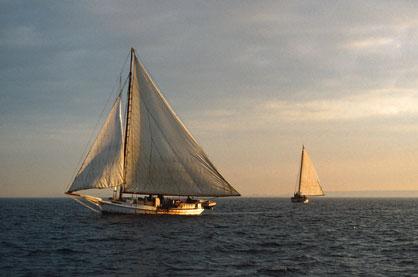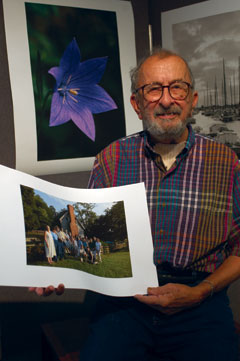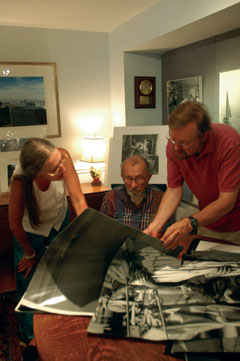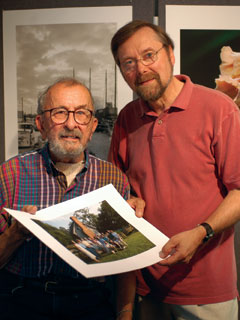A New Look
For an Old Master
By Douglas Lamborne

Marion E. Warren is 84
and has had more than his share of physical afflictions, the ideal
specimen for a rocking chair on the porch or a nursing home. But
no. There's work still to be done. Almost daily, he makes his
way through the clutter of his basement to his darkroom, as he
has for more than a half-century, to work on his photographs.
And when he is done there he moves over to his light table to
take on the gargantuan chore of editing thousands of color transparencies.
Yes, those are color transparencies by M.E. Warren, whose black
and white images hang in the State House, in countless dentists'
offices, on city buses, and over mantles across the region.
In order to appreciate this current busyness we need to take a
cursory look back. Warren took up photography at the age of 17
and soon found work in studios in St. Louis. He was a photographer
while in the Navy during World War II and served in Washington
where he met Mary Giblin, who would become his wife.
He continued to move east, to Annapolis in 1947, where he set
up shop, covering weddings and then taking on commercial assignments.
At the same time his artistic eye focused on the variety of life
in Maryland, especially life on and around the Chesapeake Bay.
Photo shoots grew into collections, collections into books.
His second book, The Train's Done Been and Gone: An Annapolis
Portrait 1859-1910, produced with daughter Mame, was published
in 1976. It comprised photos of long-ago Annapolis that the Warrens
begged, borrowed and otherwise wheedled from private collections.
Many of these photos almost certainly were retrieved from oblivion-or
worse.
 The book showed several things about Warren: his concern for historical
images and his eye for the everyday-ness of life.
The book showed several things about Warren: his concern for historical
images and his eye for the everyday-ness of life.
Both were evident in the massive body of his own work, which in
1987 he donated to the Maryland State Archives, a treasure trove
of more than 100,000 black-and-white negatives.
His next chore was the Bay Project, an intensive look at the Chesapeake,
which resulted in his seventh book, again in black and white,
Bringing Back the Bay, published in 1994 and reprinted
in 2002.
Trouble piled up for Warren as the millennium approached. His
own physical problems increased, and wife Mary slipped into the
ever-gathering darkness of Alzheimer's, which ultimately claimed
her last year.
Despite the hurdles, an exhibit of Warren's work was mounted in
2001 at the Mitchell Gallery at St. John's College. The show's
opening night was a mob scene, suggesting some sort of valedictory.
Not so. As usual, there was more work to be done.
In the hubbub attending that show Warren met Joanie Surette, a
graphic designer. The two agreed to talk, and Surette showed up
for the chat with some vine-ripened tomatoes grown on the South
County farm where she lives. The tomatoes, both agreed, helped
to seal the deal, a collaboration that led to her becoming his
business partner.
"It was one of those meetings where I think we both knew instinctively
that we could work well together," she says. He concurs: "Something
told me she and I would click. She knew how to adapt very quickly.
This was always a problem for me with people who have worked for
me in the past. I trust Joanie's judgment completely."
Surette brought order to the day-to-day running of the enterprise,
including an increase in the price of his images. Warren's eyebrows
still arc in wonder at the cost of his photographs today. (Two
photographers interviewed for this story said the price rise was
long overdue.)
 Surette freed up Warren to continue working in the darkroom. He
discovered gradually that he had a new problem: the steady demand
for certain of his photographs was causing his negatives to become
damaged or scratched. He noticed it first in his moonlit image
of the Chesapeake Bay Bridge, an iconic M.E. Warren photograph
taken in 1953. And if that weren't enough, he was coming to realize
that the high-quality paper he had been printing on-essential
for that archival look-was becoming less available.
Surette freed up Warren to continue working in the darkroom. He
discovered gradually that he had a new problem: the steady demand
for certain of his photographs was causing his negatives to become
damaged or scratched. He noticed it first in his moonlit image
of the Chesapeake Bay Bridge, an iconic M.E. Warren photograph
taken in 1953. And if that weren't enough, he was coming to realize
that the high-quality paper he had been printing on-essential
for that archival look-was becoming less available.
"A lot of people don't know that many photographers don't print
their own work," says Surette. "Marion is a master printer as
well as a master photographer." What was to be done?
A principal at the Packard Reath Gallery in Lewes, Del., two years
ago connected Warren with Richard Olsenius of Annapolis, photographer
and printer. It became a collaboration good for both.
Olsenius is a former news photographer from Minneapolis who became
a subcontractor and staffer with National Geographic. Early on,
he had an interest in large-format printing and computers, eventually
combining the two. "A tremendous new set of tools had emerged,"
he says of those early computer days. "And I chose to embrace
it."
When the National Geographic got serious about digital, Olsenius
was invited to Washington. (He and wife Christine went further
east to settle in Annapolis.)
The first Warren negative Olsenius worked with was the Bay Bridge
shot. "I'm not adding or subtracting anything," he says. "These
new tools mean I am able to work more precisely burning and dodging.
It's simply better printing."
Burning and dodging is what the photographer does in the darkroom,
massaging his prints under the dim yellow lights. The process
Olsenius uses brings out detail in negatives that had never seen
the light of day.
Asked to simplify an explanation of what he does, Olsenius offers
this: "Rather than projecting an image on a paper coated with
a silver compound, we're spraying an image on with ink. The traditional
process goes through this chain: eye to camera to film to enlarger
where the image is projected onto silver gelatin. With this digital
process it's the eye to camera to chip to computer, which acts
as the enlarger, to the printer, where it's sprayed."
 The procedure was painstaking for both. "He'll do a proof and
I will say do this or do that," says Warren. "It's a very time-consuming
process. You have to go over each print one at a time."
The procedure was painstaking for both. "He'll do a proof and
I will say do this or do that," says Warren. "It's a very time-consuming
process. You have to go over each print one at a time."
"About 10 hours into the Bay Bridge picture I almost gave up.
I thought I couldn't do it," says Olsenius. But he persisted;
it took 22 hours to make it right. "Now, I think I know what he
wants in his prints. Ultimately, the final call resides with him.
There's a lot of back-and-forth, a real collaboration."
He worked on a number of images, using archival paper essential
to his process, paper that also satisfies Warren's demands.
"Marion's been a remarkable shot in the arm for all of us involved
with him," says Olsenius. "Certainly for me. He keeps raising
the bar, showing you can be creative well into your 80s. He proves
to me that the creative drive does not have physical limits. I
think this work has rejuvenated him. It certainly has rejuvenated
me."
After restoring a number of his classic black-and-whites, Olsenius
took on some of Warren's color.
"I've been shooting color all along," says Warren, "since the
1940s." The color that saw the light of day over the decades was
usually commercial work. "I was never satisfied with the quality
of the printing process," he says of his artistic images. Olsenius
has changed that. In the last year some of his color has been
shown at Packard Reath and at DeMatteis Gallery on West Street.
"I didn't think he would get the same reaction with the color
as he has for the black and white," says Bobbie DeMatteis, who
offers Warrens in all hues. "But he has. The color has been accepted
quite well."
The Washington Post Magazine did a cover story on Marion Warren
in 2002 and entitled it "Almost Famous." The article addressed
a touchy matter, the Warren legacy. He has never been the sort
to toot his own horn-he's too nice a guy for that. And he certainly
isn't going to hire someone to do the tooting for him. His work,
some feel, speaks for itself. Eloquently.
There is gathering evidence that his art is not only going to
endure, but become essential. Take, for example, his Chesapeake
Bay work-skipjacks in the morning mist, fleets of workboats tied
up at City Dock, hand tongers scraping for oysters. These images
are vanishing fast. Decades down the road, if you want to find
out what the Bay was like back then, you would go to photographs
by M. E. Warren.
DeMatteis says it is happening now: "A lot of my customers tell
me they realize that what was captured in these images is gone
or soon will be."
Back
|

